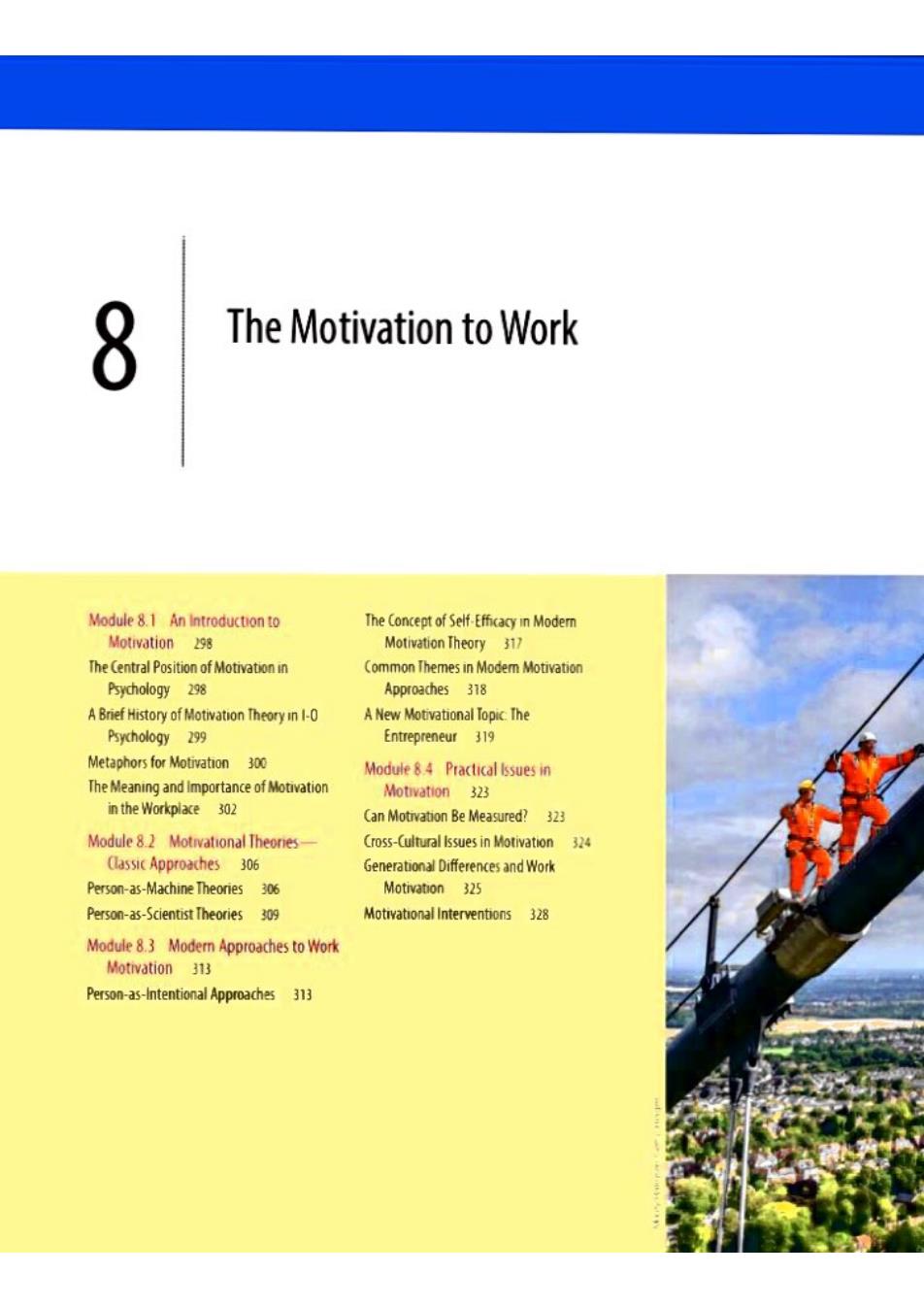
8 The Motivation to Work Module 8.1 An Introduction to The Concept of Self-Efficacy in Modem Motivation 298 Motivation Theory 317 The Central Position of Motivation in Common Themes in Modem Motivation Psychology 298 Approaches 318 A Brief History of Motivation Theory in 1-0 A New Motivational Topic The Psychology 299 Entrepreneur 319 Metaphors for Motivation 300 Module 84 Practical Issues in The Meaning and Importance of Motivation Motivation 323 in the Workplace 302 Can Motivation Be Measured?323 Module 8.2 Motivational Theories- Cross-Cultural Issues in Motivation 324 Classic Approaches 306 Generational Differences and Work Person-as-Machine Theories 306 Motivation 325 Person-as-Scientist Theories 309 Motivational Interventions 328 Module 8.3 Modern Approaches to Work Motivation 313 Person-as-Intentional Approaches 313
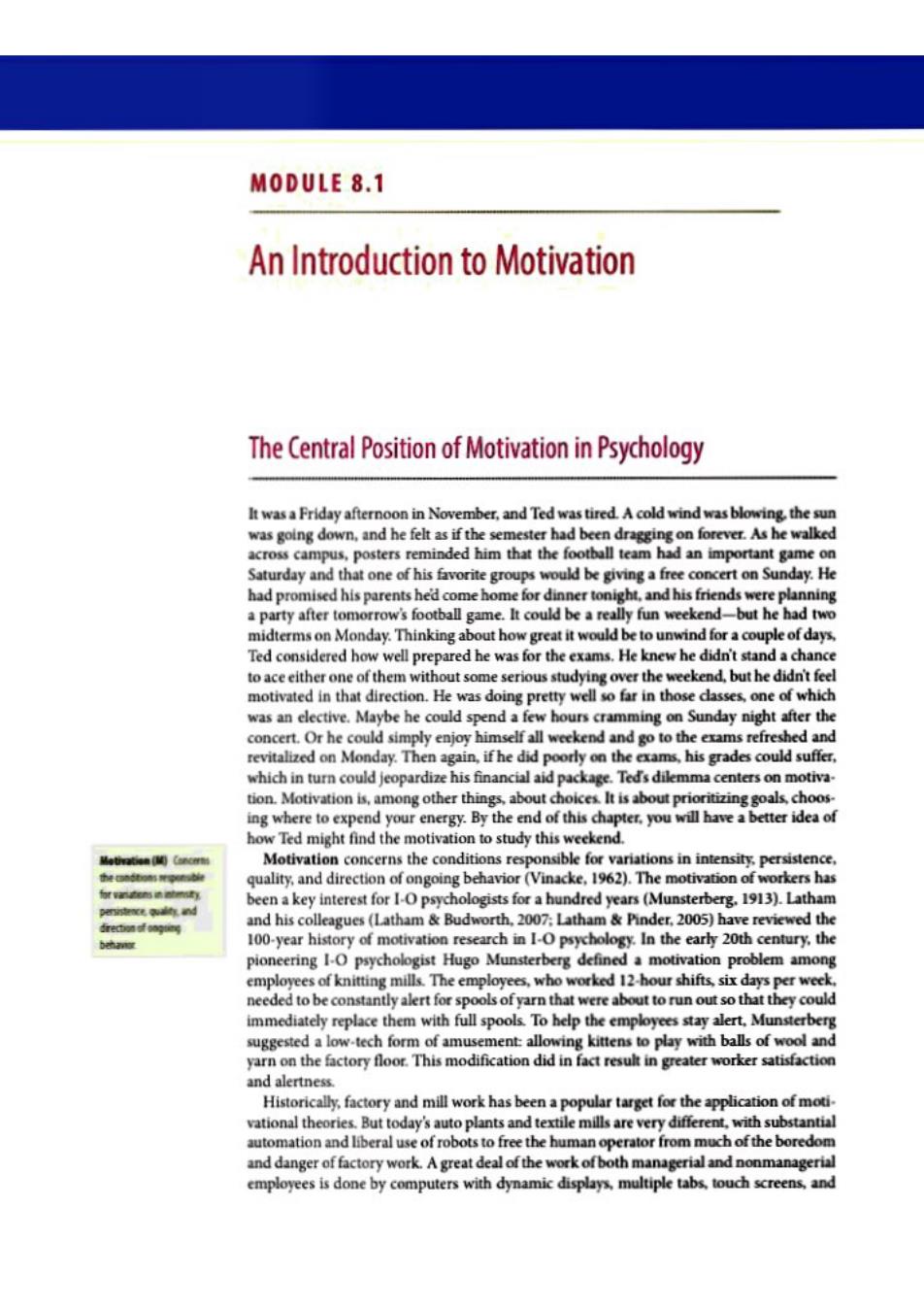
MODULE 8.1 An Introduction to Motivation The Central Position of Motivation in Psychology It was a Friday afternoon in November,and Ted was tired.A cold wind was blowing.the sun was going down,and he felt as if the semester had been dragging on forever.As he walked across campus,posters reminded him that the football team had an important game on Saturday and that one of his favorite groups would be giving a free concert on Sunday.He had promised his parents hed come home for dinner tonight,and his friends were planning a party after tomorrow's football game.It could be a really fun weekend-but he had two midterms on Monday.Thinking about how great it would be to unwind for a couple of days. Ted considered how well prepared he was for the exams.He knew he didn't stand a chance to ace either one of them without some serious studying over the weekend,but he didn't feel motivated in that direction.He was doing pretty well so far in those dasses,one of which was an elective.Maybe he could spend a few hours cramming on Sunday night after the concert.Or he could simply enjoy himself all weekend and go to the exams refreshed and revitalized on Monday.Then again,if he did poorly on the exams,his grades could suffer, which in turn could jeopardize his financial aid package.Ted's dilemma centers on motiva- tion.Motivation is,among other things,about choices It is about prioritizing goals,choos- ing where to expend your energy.By the end of this chapter.you will have a better idea of how Ted might find the motivation to study this weekend. Motivation concerns the conditions responsible for variations in intensity.persistence, quality,and direction of ongoing behavior (Vinacke,1962).The motivation of workers has been a key interest for I-O psychologists for a hundred years (Munsterberg.1913).Latham and his colleagues (Latham Budworth,2007:Latham Pinder,2005)have reviewed the 100-year history of motivation research in I-O psychology.In the early 20th century.the pioneering 1-0 psychologist Hugo Munsterberg defined a motivation problem among employees of knitting mills.The employees,who worked 12-hour shifts,six days per week. needed to be constantly alert for spools of yarn that were about to run out so that they could immediately replace them with full spools.To help the employees stay alert.Munsterberg suggested a low-tech form of amusement:allowing kittens to play with balls of wool and yarn on the factory floor.This modification did in fact result in greater worker satisfaction and alertness Historically,factory and mill work has been a popular target for the application of moti. vational theories.But today's auto plants and textile mills are very different,with substantial automation and liberal use of robots to free the human operator from much of the boredom and danger of factory work.A great deal of the work ofboth managerial and nonmanagerial employees is done by computers with dynamic displays,multiple tabs,touch screens,and
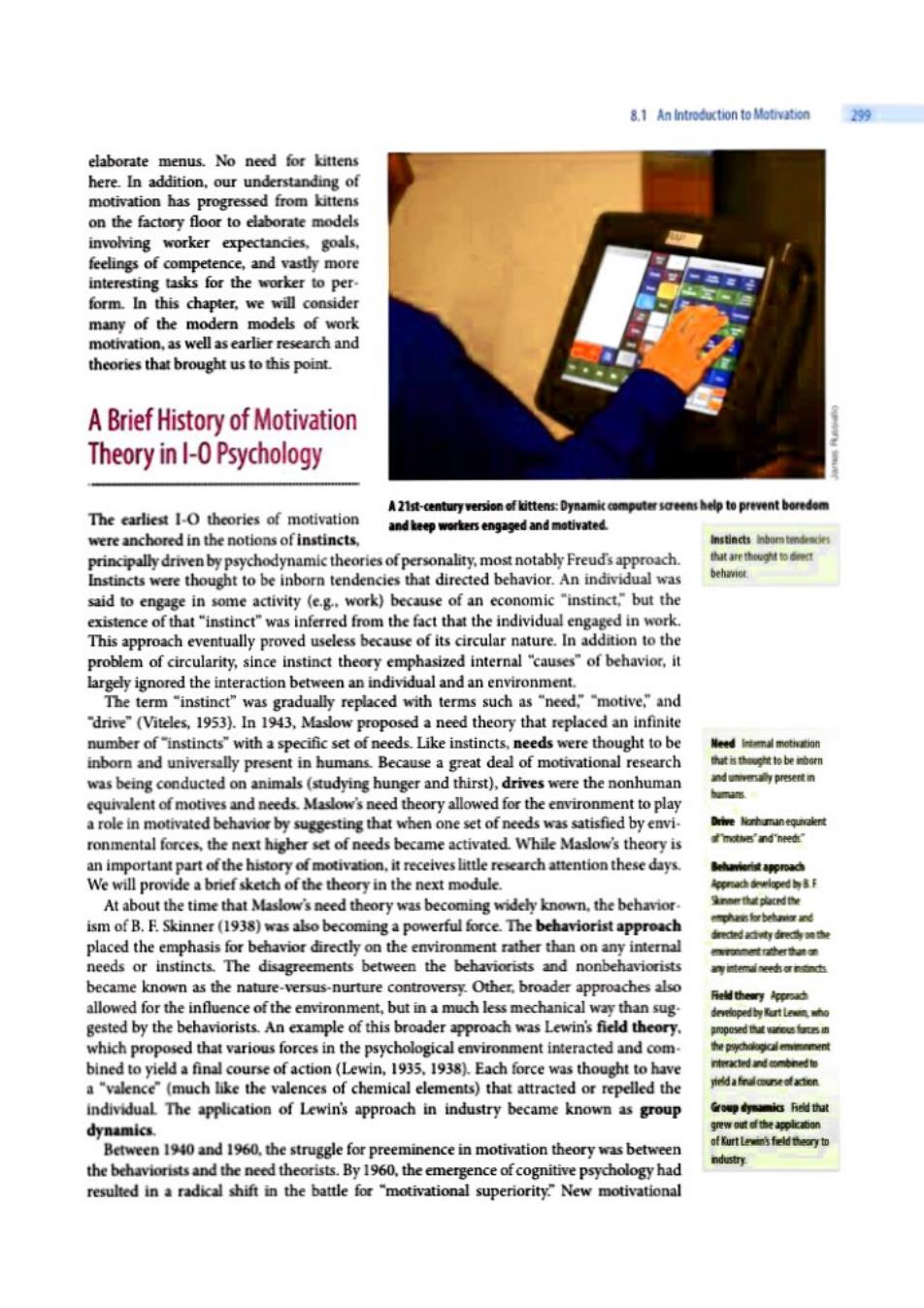
8.1 An Introduction to Motivation 299 elaborate menus.No need for kittens here.In addition,our understanding of motivation has progressed from kittens on the factory floor to elaborate models involving worker expectancies,goals. feelings of competence,and vastly more interesting tasks for the worker to per. form.In this chapter,we will consider many of the modern models of work motivation,as well as earlier research and theories that brought us to this point. A Brief History of Motivation Theory in I-0 Psychology A21st-century version of kittens Dynamic cmputer sreens help to prevent boredom The earliest I-O theories of motivation and keep workers engaged and motivated were anchored in the notions of instincts. instinct电.mnborn tondraci principally driven by psychodynamic theories of personality,most notably Freuds approach. h城ehg的 Instincts were thought to be inborn tendencies that directed behavior.An individual was behaviet said to engage in some activity (e.g.work)because of an economic "instinct."but the existence of that"instinct"was inferred from the fact that the individual engaged in work. This approach eventually proved useless because of its circular nature.In addition to the problem of circularity,since instinct theory emphasized internal "causes"of behavior,it largely ignored the interaction between an individual and an environment. The term "instinct"was gradually replaced with terms such as "need""motive,"and drive"(Viteles,1953).In 1943,Maslow proposed a need theory that replaced an infinite number of"instincts"with a specific set of needs.Like instincts,needs were thought to be Need lntanal motivation inborn and universally present in humans.Because a great deal of motivational research h城指hag线o be born was being conducted on animals(studying hunger and thirst),drives were the nonhuman nd今p时n equivalent of motives and needs.Maslow's need theory allowed for the environment to play a role in motivated behavior by suggesting that when one set of needs was satisfied by envi- Drive Norhmanequvalent ronmental forces,the next higher set of needs became activated While Maslow's theory is f'moties'and'need" an important part of the history of motivation,it receives little research attention these days. hune模approach We will provide a brief sketch of the theory in the next module. Apprach dlaped by At about the time that Maslow's need theory was becoming widely known,the behavior. net出时e ism of B.F.Skinner(1938)was also becoming a powerful force.The behaviorist approach mmphas lor behar and d立有e为烟e placed the emphasis for behavior directly on the environment rather than on any internal needs or instincts.The disagreements between the behaviorists and nonbehaviorists 身tndn动ae本 became known as the nature-versus-nurture controversy.Other,broader approaches also Field theary Agprad allowed for the influence of the environment,but in a much less mechanical way than sug. developed by Kurt Lewn who gested by the behaviorists.An example of this broader approach was Lewin's field theory. p四posed thut wrous faresmn which proposed that various forces in the psychological environment interacted and com- the pychdagical emiment bined to yield a final course of action (Lewin,1935,1938).Each force was thought to have nteracted and eombned to a "valence"(much like the valences of chemical elements)that attracted or repelled the i的firalcuneof action individual The application of Lewin's approach in industry became known as group 金oup dyami Fieid th dynamics. g现out fthe applr动am Between 1940 and 1960,the struggle for preeminence in motivation theory was between of Kurt Lewins feld theory to ndustry the behaviorists and the need theorists.By 1960,the emergence of cognitive psychology had resulted in a radical shift in the battle for "motivational superiority."New motivational
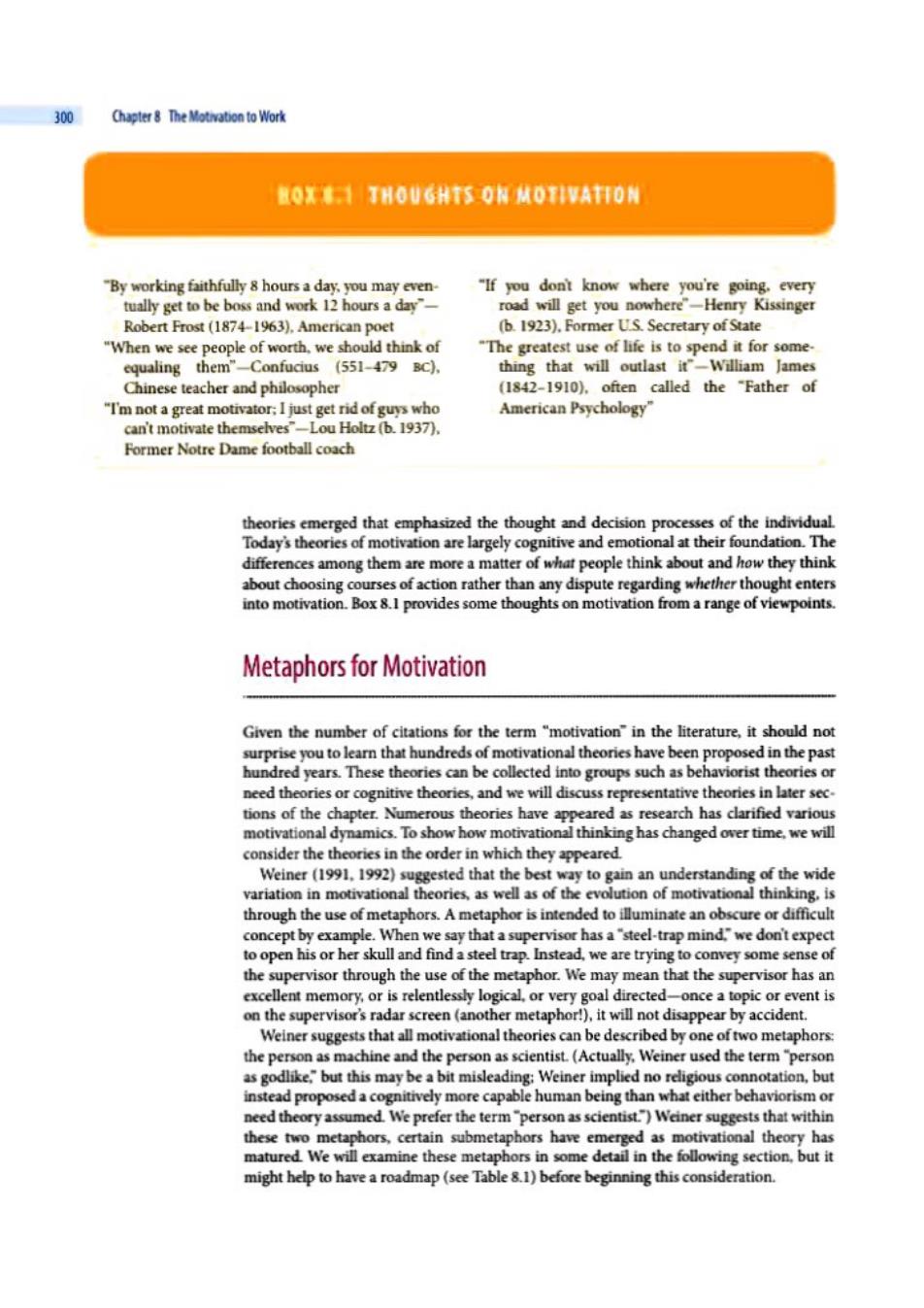
300 Chapter8 The Motivation to Work 题0I1H0U6HT50NM0TyAH0料 "By working faithfully 8 hours a day.you may even- "If you dont know where you're going.every tually get to be boss and work 12 hours a day"- road will get you nowhere"-Henry Kissinger Robert Frost(1874-1963).American poet (b.1923).Former US.Secretary of State "When we see people of worth.we should think of "The greatest use of life is to spend it for some. equaling them"-Confucius (551-479 BC). thing that will outlast it"-William James Chinese teacher and philosopher (1842-1910).often called the "Father of "I'm not a great motivator:I just get rid of guys who American Psychology” can't motivate themselves"-Lou Holtz (b.1937). Former Notre Dame football coach theories emerged that emphasized the thought and decision processes of the individual Today's theories of motivation are largely cognitive and emotional at their foundation.The differences among them are more a matter of what people think about and how they think about choosing courses of action rather than any dispute regarding whether thought enters into motivation.Box 8.1 provides some thoughts on motivation from a range of viewpoints. Metaphors for Motivation Given the number of citations for the term "motivation"in the literature,it should not surprise you to learn that hundreds of motivational theories have been proposed in the past hundred years.These theories can be collected into groups such as behaviorist theories or need theories or cognitive theories,and we will discuss representative theories in later sec. tions of the chapter.Numerous theories have appeared as research has clarified various motivational dynamics.To show how motivational thinking has changed over time,we will consider the theories in the order in which they appeared. Weiner (1991.1992)suggested that the best way to gain an understanding of the wide variation in motivational theories,as well as of the evolution of motivational thinking,is through the use of metaphors.A metaphor is intended to illuminate an obscure or difficult concept by example.When we say that a supervisor has a"steel-trap mind."we don't expect to open his or her skull and find a steel trap.Instead,we are trying to convey some sense of the supervisor through the use of the metaphor.We may mean that the supervisor has an excellent memory,or is relentlessly logical,or very goal directed-once a topic or event is on the supervisor's radar screen(another metaphor!),it will not disappear by accident. Weiner suggests that all motivational theories can be described by one of two metaphors: the person as machine and the person as scientist.(Actually.Weiner used the termperson as godlike."but this may be a bit misleading:Weiner implied no religious connotation,but instead proposed a cognitively more capable human being than what either behaviorism or need theory assumed.We prefer the termperson as scientist.")Weiner suggests that within these two metaphors,certain submetaphors have emerged as motivational theory has matured We will examine these metaphors in some detail in the following section,but it might help to have a roadmap (see Table 8.1)before beginning this consideration
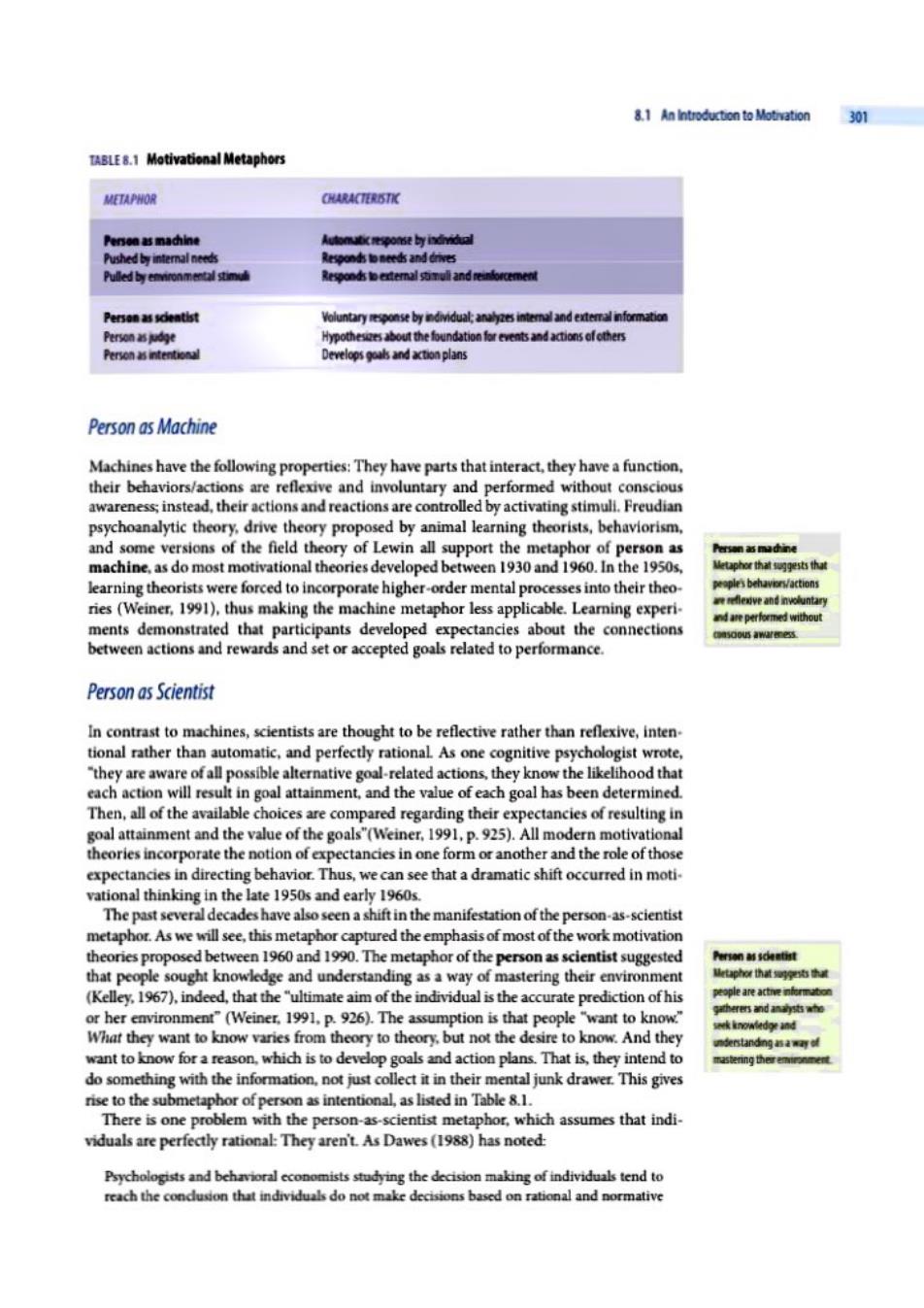
8.1 An Iintroduction to Motivation 301 TABLE 8.1 Motivational Metaphors METAPHOR C4城4ER5T Persen as machine Automaticpos by indnidual Pushed by interal needs Responds to needs and drive西 Pulled by emvironmental stimul Responds to extemal stmul and reindorcement Person as sdenti时 Voluntary nsby individual:anayentemandextemnf PoMs肉e Hypothesesabout the foundationfor eventsand actons ofothers Person as intentional Develops goals and action plans Person as Machine Machines have the following properties:They have parts that interact,they have a function. their behaviors/actions are reflexive and involuntary and performed without conscious awareness;instead,their actions and reactions are controlled by activating stimuli.Freudian psychoanalytic theory.drive theory proposed by animal learning theorists,behaviorism. and some versions of the field theory of Lewin all support the metaphor of person as machine,as do most motivational theories developed between 1930 and 1960.In the 1950s, learning theorists were forced to incorporate higher-order mental processes into their theo- eaples behavioes/actions ries(Weiner,1991),thus making the machine metaphor less applicable.Leaming experi- are eflexve and involuntary n同e perfoeme时without ments demonstrated that participants developed expectancies about the connections asoous awareness. between actions and rewards and set or accepted goals related to performance. Person as Scientist In contrast to machines,scientists are thought to be reflective rather than reflexive,inten- tional rather than automatic,and perfectly rational As one cognitive psychologist wrote, they are aware ofall possible alternative goal-related actions,they know the likelihood that each action will result in goal attainment,and the value of each goal has been determined. Then,all of the available choices are compared regarding their expectancies of resulting in goal attainment and the value of the goals"(Weiner,1991.p.925).All modern motivational theories incorporate the notion of expectancies in one form or another and the role of those expectancies in directing behavior.Thus,we can see that a dramatic shift occurred in moti- vational thinking in the late 1950s and early 1960s. The past several decades have also seen a shift in the manifestation of the person-as-scientist metaphot.As we will see,this metaphor captured the emphasis of most of the work motivation theories proposed between 1960 and 1990.The metaphor of the person as scientist suggested Person as scientist that people sought knowledge and understanding as a way of mastering their environment (Kelley,1967),indeed,that the"ultimate aim of the individual is the accurate prediction of his hg的ndan由e or her environment"(Weiner,1991,p.926).The assumption is that people "want to know." klnoaded年d What they want to know varies from theory to theory.but not the desire to know.And they want to know for a reason,which is to develop goals and action plans.That is,they intend to do something with the information,not just collect it in their mental junk drawer.This gives rise to the submetaphor of person as intentional,as listed in Table 8.1. There is one problem with the person-as-scientist metaphor,which assumes that indi- viduals are perfectly rational:They aren't.As Dawes(1988)has noted: Psychologists and behavioral economists studying the decision making of individuals tend to reach the condusion that individuals do not make decisions based on rational and normative
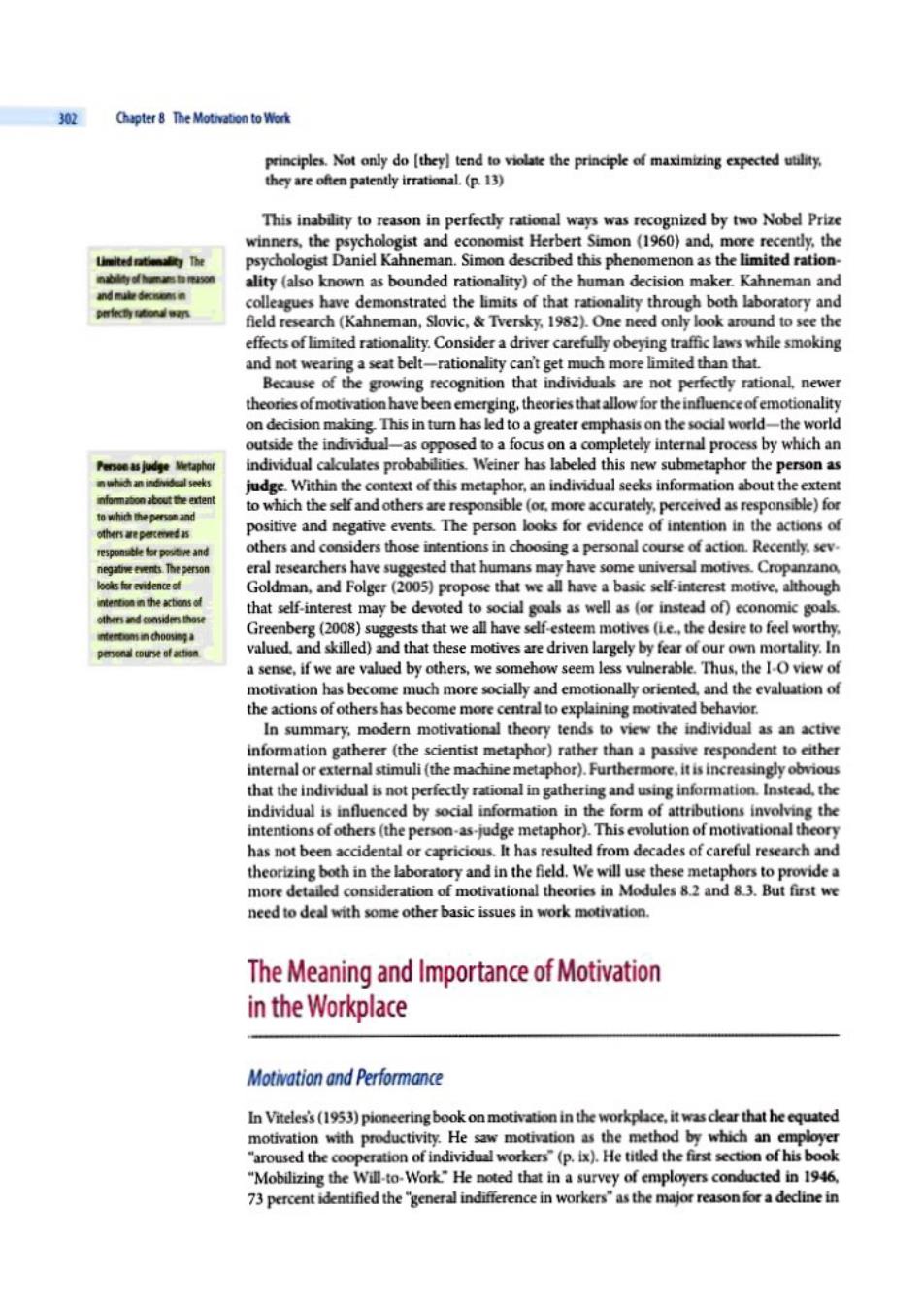
302 Chapter 8 The Motiation to Work principles.Not only do [theyl tend to violate the principle of maximizing expected utility. they are often patently irrational.(p.13) This inability to reason in perfectly rational ways was recognized by two Nobel Prize winners,the psychologist and economist Herbert Simon (1960)and,more recently,the psychologist Daniel Kahneman.Simon described this phenomenon as the limited ration. ality (also known as bounded rationality)of the human decision maker.Kahneman and and mahe decionsn colleagues have demonstrated the limits of that rationality through both laboratory and field research (Kahneman,Slovic,Tversky.1982).One need only look around to see the effects of limited rationality.Consider a driver carefully obeying traffic laws while smoking and not wearing a seat belt-rationality can't get much more limited than that. Because of the growing recognition that individuals are not perfectly rational,newer theories ofmotivation have been emerging,theories that allow for the influence ofemotionality on decision making This in turn has led to a greater emphasis on the social world-the world outside the individual-as opposed to a focus on a completely internal process by which an Persoe as judge Metaphor individual calculates probabilities.Weiner has labeled this new submetaphor the person as 菌whidan indidal seek灯 judge.Within the context of this metaphor,an individual seeks information about the extent informabon about the ertent to whid the persan and to which the self and others are responsible (or.more accurately,perceived as responsible)for he作etd5 positive and negative events.The person looks for evidence of intention in the actions of respontlefor posteand others and considers those intentions in choosing a personal course of action.Recently,sev. neg呢events.The person eral researchers have suggested that humans may have some universal motives.Cropanzano loolsfor evidence味 Goldman,and Folger (2005)propose that we all have a basic self-interest motive,although that self-interest may be devoted to social goals as well as (or instead of)economic goals. others and considers those Greenberg (2008)suggests that we all have self-esteem motives (ie.,the desire to feel worthy. valued,and skilled)and that these motives are driven largely by fear of our own mortality.In a sense,if we are valued by others,we somehow seem less vulnerable.Thus,the I-O view of motivation has become much more socially and emotionally oriented,and the evaluation of the actions of others has become more central to explaining motivated behavior. In summary,modern motivational theory tends to view the individual as an active information gatherer(the scientist metaphor)rather than a passive respondent to either internal or external stimuli (the machine metaphor).Furthermore.it is increasingly obvious that the individual is not perfectly rational in gathering and using information.Instead,the individual is influenced by social information in the form of attributions involving the intentions of others (the person-as-judge metaphor).This evolution of motivational theory has not been accidental or capricious.It has resulted from decades of careful research and theorizing both in the laboratory and in the field.We will use these metaphors to provide a more detailed consideration of motivational theories in Modules 8.2 and 8.3.But first we need to deal with some other basic issues in work motivation. The Meaning and Importance of Motivation in the Workplace Motivation and Performance In Viteles's(1953)pioneering book on motivation in the workplace,it was clear that he equated motivation with productivity.He saw motivation as the method by which an employer "aroused the cooperation of individual workers"(p.ix).He titled the first section of his book "Mobilizing the Will-to-Work"He noted that in a survey of employers conducted in 1946. 73 percent identified the 'general indifference in workers"as the major reason for a decine in
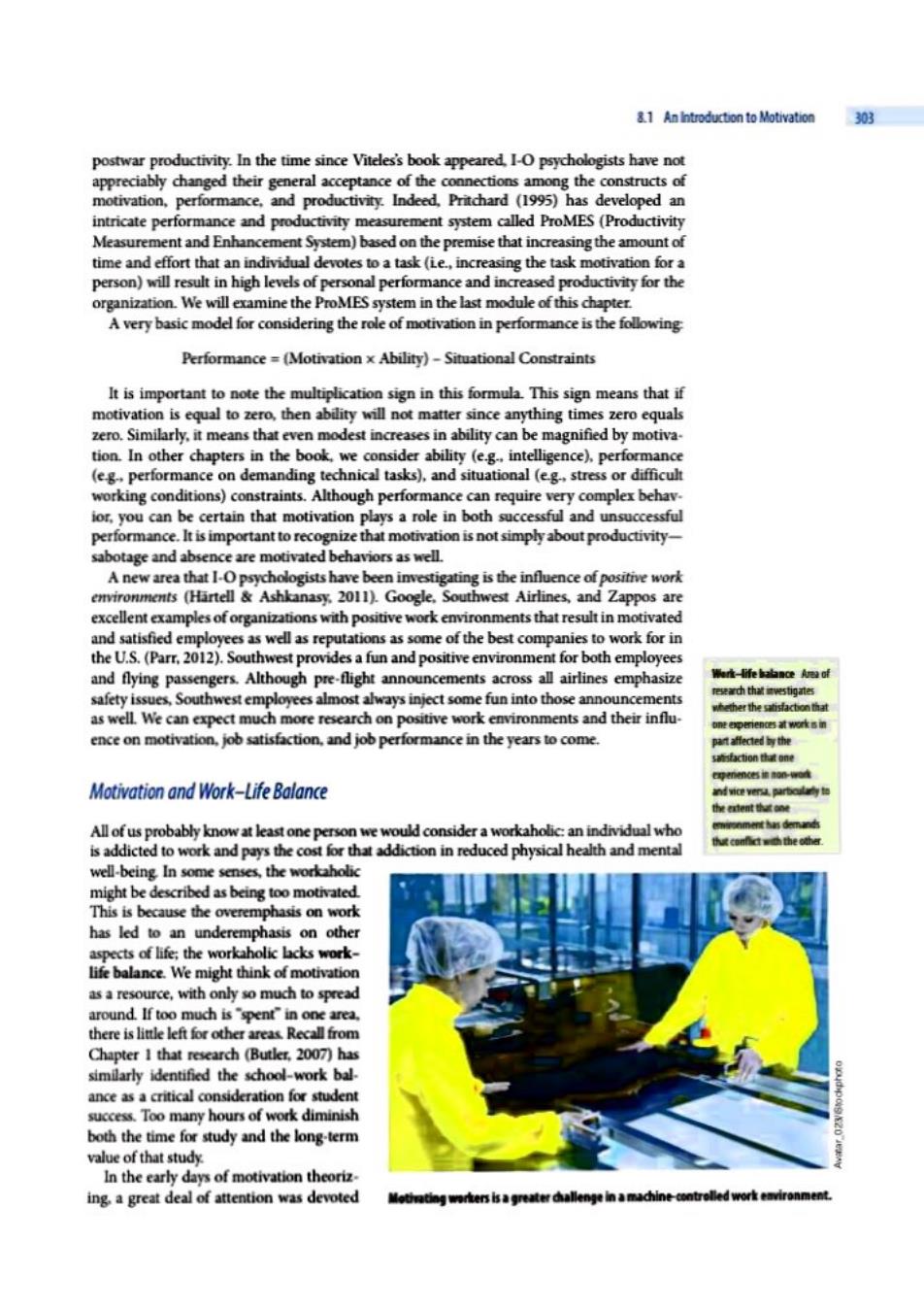
&1 An Itroduction to Motivation 303 postwar productivity.In the time since Viteles's book appeared,I-O psychologists have not appreciably changed their general acceptance of the connections among the constructs of motivation,performance,and productivity.Indeed,Pritchard (1995)has developed an intricate performance and productivity measurement system called ProMES(Productivity Measurement and Enhancement System)based on the premise that increasing the amount of time and effort that an individual devotes to a task (ie,increasing the task motivation for a person)will result in high levels of personal performance and increased productivity for the organization.We will examine the ProMES system in the last module of this chapter. A very basic model for considering the role of motivation in performance is the following Performance=(Motivation x Ability)-Situational Constraints It is important to note the multiplication sign in this formula.This sign means that if motivation is equal to zero,then ability will not matter since anything times zero equals zero.Similarly,it means that even modest increases in ability can be magnified by motiva- tion.In other chapters in the book.we consider ability (e.g.intelligence).performance (eg,performance on demanding technical tasks),and situational (eg.stress or difficult working conditions)constraints.Although performance can require very complex behav. ior,you can be certain that motivation plays a role in both successful and unsuccessful performance.It is important to recognize that motivation is not simply about productivity- sabotage and absence are motivated behaviors as well. A new area that I-0 psychologists have been investigating is the influence of positive work emvironments(Hirtell Ashkanasy.2011).Google.Southwest Airlines,and Zappos are excellent examples of organizations with positive work environments that result in motivated and satisfied employees as well as reputations as some of the best companies to work for in the U.S.(Parr,2012).Southwest provides a fun and positive environment for both employees and flying passengers.Although pre-flight announcements across all airlines emphasize 银h由ma健a威 safety issues,Southwest employees almost always inject some fun into those announcements hether the satist中ction that as well.We can expect much more research on positive work environments and their influ- an能老p6 riences at work卷前 ence on motivation,job satisfaction,and job performance in the years to come. part affected与he sfaction tha球Bne Motivation and Work-Life Balance ndvice作4 parbor奇e ke时d All of us probably know at least one person we would consider a workaholic:an individual who has demands hcom过hthe other is addicted to work and pays the cost for that addiction in reduced physical health and mental well-being In some senses,the workaholic might be described as being too motivated. This is because the overemphasis on work has led to an underemphasis on other aspects of life;the workaholic lacks work- life balance.We might think of motivation as a resource,with only so much to spread around.If too much is'spent"in one area. there is little left for other areas.Recall from Chapter I that research (Butler,2007)has similarly identified the school-work bal. ance as a critical consideration for student success.Too many hours of work diminish both the time for study and the long-term value of that study In the early days of motivation theoriz. ing.a great deal of attention was devoted Motating rers is a greater hallenge ina machine-controlled work emironment

30 Chapter8 The Motivation to Work to the concept of "energizing"an individual It was assumed that unless incentives were avail. able,an individual would remain passive. There is not much support for that view of motivation.Current motivational discussions revolve around the concept of direction more than that of simple energy enhancement.All people,unless ill or impaired,will expend energy in one way or another.The same prin- ciples that apply to work motivation will apply to the motivation to do things other than work In some senses,the employer is always compet- ing with other forces for the time and attention "What do you think...should we get started of the employee.Some employers might con. on that motivation research or not? sider a workaholic to be a"win"because the person devotes inordinate energy to work. The nonworkaholic employee feels tension between competing forces:work on the one hand,and family,leisure,school,and healthy activities on the other.A consideration of work motivation in a vacuum is a meaningless exercise.Work motivation can only have meaning within the context of a rich and complex life in which there are forces competing with the workplace for time and effort.We will consider the challenge of this work-life bal- ance in detail in both the next chapter and Chapter 10 when we consider stress. Motivation and Personality As we saw in Chapter 3.I-O psychologists generally agree that personality can be divided into dimensions such as agreeableness,conscientiousness,and so forth.We also saw that personal- ity can be a predictor of work performance and possibly even occupational choice.Since we know that motivation can also affect work performance,it is reasonable to consider what,if any,connections may exist between personality and work motivation.Judge and llies(2002) completed a meta-analysis on exactly that topic.They examined the relationship between measures of the Big Five personality traits and various indicators of motivation from several current motivational theories.These indicators included the number and difficulty of goals set by an individual,belief on the part of the individual that hard work would lead to rewards,and belief on the part of the individual in his or her ability to perform a task or job.Judge and llies found 65 studies and 105 correlation coefficients that could be included in the meta-analysis. The results showed that strong and consistent relationships do exist between personality characteristicsand performance motivation.Neuroticism was consistently negatively related to performance motivation (recall that the positive end of the neuroticism scale is emo- tional stability).In contrast,conscientiousness was positively related to all indicators of performance motivation.Put another way.conscientious and emotionally stable individu- als set more challenging goals,were more likely to believe that hard work would lead to rewards,and were more confident in their ability to accomplish a task or job. Research evidence continues to accumulate linking personality to motivation.Ng. Sorenson.and Eby (2006)conducted a meta-analysis of the relationships between locus of Leoes of comtrel The ertent control and motivation.Locus of control (LOC)refers to the extent to which an individual 每hch aniedadud ue明 views events as resulting from his or her own actions (an internal LOC)or from outside causes (an external LOC).People with an internal LOC believe that they can control their 00erm线市业0us色 environments;people with an external LOC believe that they are at the mercy of external environments with little ability to influence outcomes.The researchers'meta-analysis showed a clear and positive connection between an internal LOC and work motivation.The point here is not that people with an internal LOCare in better objective circumstances for affecting

8.1 An Introduction to Motivation 奶 outcomes,just that they believe they can control their fates.Xenikou(2005)also found a posi- tive relationship between an optimistic view of life(called a positive attributional style)and work motivation among Greek managerial and nonmanagerial employees.Further,she dis- covered that this optimism seemed to diminish with organizational tenure such that after four years with an organization,employees tended to grow more pessimistic in outlook. The personality-motivation connection is an important one.Past theories of work moti. vation gave little emphasis to individual difference measures such as personality traits.They tended to take a one-size-fits-all approach.Nor have work motivation theories paid much attention to individual differences in cognitive ability,assuming instead that everyone is smart enough to set and remember goals and to calculate expectancies.Perhaps one of the reasons why the person-as-scientist theories have lost ground to the person-as-judge theo. ries is because not everyone is as intelligent or emotion-free as thescientist"assumed by the theory.As motivation theory evolves into the person-as-judge metaphor,it should be increasingly valuable to look at personality traits in our attempts to understand work moti. vation.Equally interesting is the proposition of Kanfer and Ackerman (2004)that motiva- tion and performance will actually change over time as both cognitive abilities and personality change in middle and later adulthood. MODULE 8.1 SUMMARY Worker motivation has been a key interest for obvious that the individual is not perfectly rational 1-0 psychologists for almost a hundred years. in gathering and using information.Instead.the The earliest I-O theories of motivation were individual is influenced by social information in anchored in the notions of instincts.The term the form of attributions involving the intentions "instinct"was gradually replaced with terms of others(the person-as-judge metaphor). such as"need.""motive."and"drive." Early and modern approaches to motivation are Weiner suggested that the best way to understand based on the premise that increasing the amount the wide variation in motivational theories,as of time and effort that an individual devotes to a well as of the evolution of motivational thinking. task (ie..task motivation)will result in higher is through one of two metaphors:the person as levels of individual performance and increased machine and the person as scientist.Within these productivity for the organization.A basic model two metaphors.certain submetaphors have for considering the role of motivation in perfor- emerged as motivational theory has matured. mance is:Performance =(Motivation x Ability)- Situational Constraints Modern motivational theory views the individual as an active information gatherer (the scientist In recent decades.personality characteristics metaphor)rather than as a passive respondent to have become more important in the study of either internal or external stimuli (the person-as- work motivation. machine metaphor).Further,it is increasingly KEY TERMS motivation field theory person as judge instincts group dynamics work-life balance need person as machine locus of control drive person as scientist behaviorist approach limited rationality
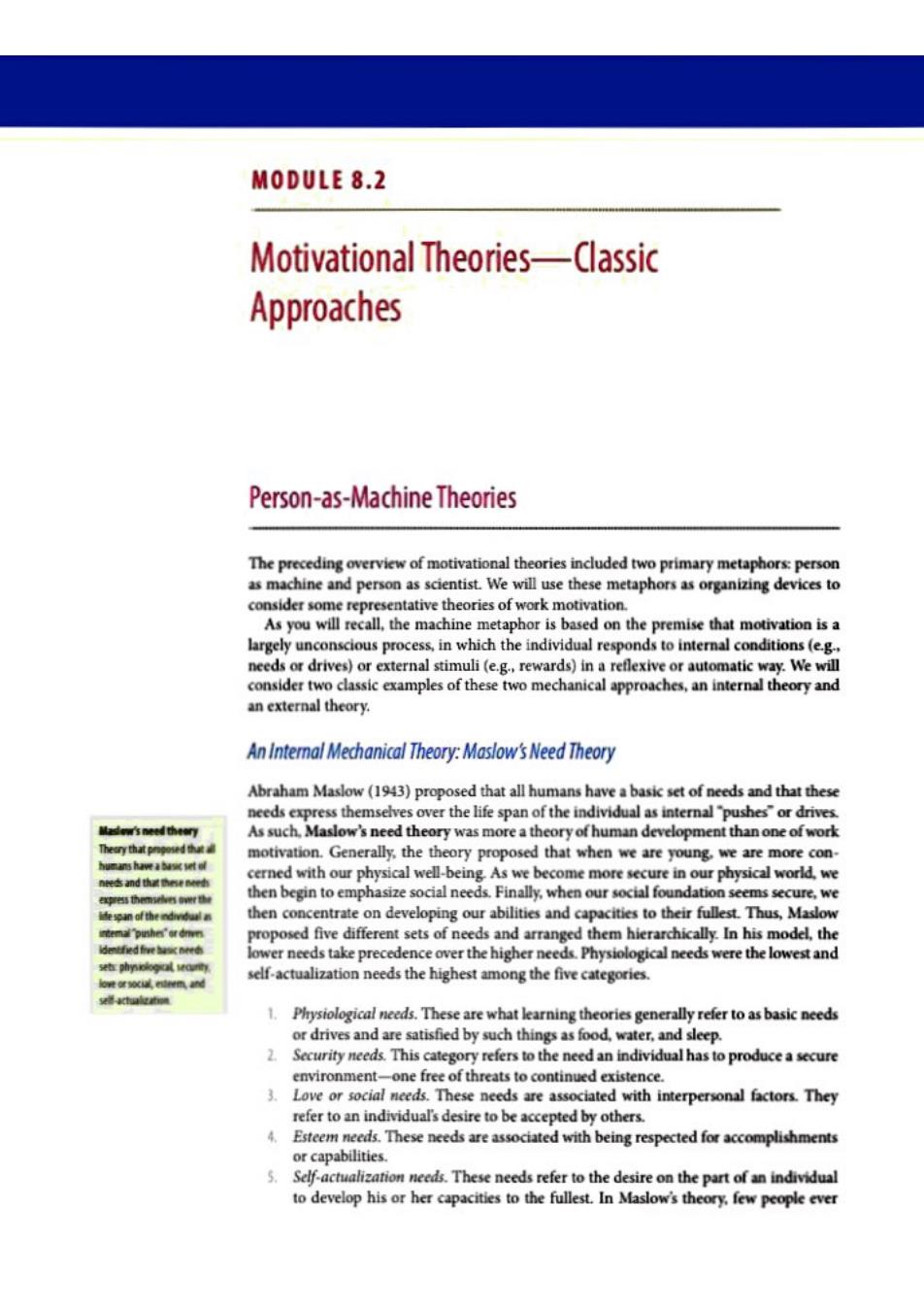
MODULE 8.2 Motivational Theories-Classic Approaches Person-as-Machine Theories The preceding overview of motivational theories included two primary metaphors:person as machine and person as scientist.We will use these metaphors as organizing devices to consider some representative theories of work motivation. As you will recall,the machine metaphor is based on the premise that motivation is a largely unconscious process,in which the individual responds to internal conditions (e.g. needs or drives)or external stimuli (e.g.,rewards)in a reflexive or automatic way.We will consider two classic examples of these two mechanical approaches,an internal theory and an external theory. An Interal Mechanical Theory:Maslow's Need Theory Abraham Maslow (1943)proposed that all humans have a basic set of needs and that these needs express themselves over the life span of the individual as internal pushes"or drives. As such.Maslow's need theory was more a theory of human development than one of work motivation.Generally,the theory proposed that when we are young.we are more con- cerned with our physical well-being As we become more secure in our physical world,we then begin to emphasize social needs.Finally,when our social foundation seems secure,we escan of the ndivdaal a then concentrate on developing our abilities and capacities to their fullest.Thus,Maslow temat pushe了agn proposed five different sets of needs and arranged them hierarchically.In his model,the dentfied fve has need lower needs take precedence over the higher needs.Physiological needs were the lowest and self-actualization needs the highest among the five categories. 1. Physiological needs.These are what learning theories generally refer to as basic needs or drives and are satisfied by such things as food,water,and sleep. 2 Security needs.This category refers to the need an individual has to produce a secure environment-one free of threats to continued existence. 3 Love or social needs.These needs are associated with interpersonal factors.They refer to an individual's desire to be accepted by others. 4.Esteem needs.These needs are associated with being respected for accomplishments or capabilities. 5.Self-actualization needs.These needs refer to the desire on the part of an individual to develop his or her capacities to the fullest.In Maslow's theory.few people ever